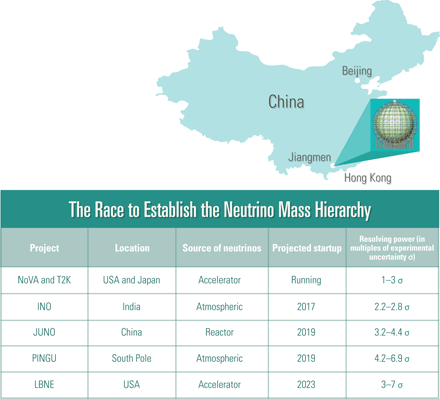China builds mammoth detector to probe mysteries of neutrino mass
BEIJING—It isn't easy to weigh a ghost. After neutrinos were hypothesized in 1930, it took physicists 67 years to prove that these elusive particles—which zip
 |
|
China hopes its planned JUNO detector, 38 meters across, will be the first to nail which of the three neutrino flavors is heavier or lighter. CREDITS: (INSET) IHEP; (SOURCE) M. BLENNOWET AL.ARXIV 1311.1822 (2013) |
through our bodies by the trillions each second—have mass at all. Now, a Chinese-led team is planning a mammoth neutrino detector, meant to capture enough neutrinos from nearby nuclear reactors to determine which of the three known types, or flavors, of neutrinos are heavier or lighter. That mass hierarchy could be key to explaining how neutrinos get their mass, and measuring it would be a coup for China's particle physicists.
Last month, scientists gathered in Jiangmen, in China's southern Guangdong province, to review plans for the Jiangmen Underground Neutrino Observatory (JUNO). Groundbreaking is slated for later this year on the $300 million facility, which China aims to complete by 2019. The facility, which backers say will be twice as sensitive as existing detectors, should not only pin down key properties of neutrinos themselves but also detect telltale neutrinos from nuclear reactions in the sun, Earth, and supernovas.
Other planned facilities aim to reveal the mass hierarchy (see table), but China could be the first to arrive at an ironclad result. If China can pull it off, says William McDonough, a geologist at the University of Maryland, College Park, JUNO "will not only lead to breakthroughs in neutrino physics, but revolutionize the field of geology and astrophysics." A successful project would also mark another triumph for China's neutrino research, 2 years after the Daya Bay Reactor Neutrino Experiment in Guangdong nailed a key parameter describing how different types of neutrinos morph into one another (Science, 16 March 2012, p. 1287).
In 1998, physicists working with the subterranean particle detector Super-Kamiokande in Japan showed that neutrinos of one flavor, muon neutrinos generated by cosmic rays in the atmosphere, can change flavor as they zip through Earth. In 2001, researchers at the Sudbury Neutrino Observatory in Canada proved that electron neutrinos from the sun do the same. Such neutrino "oscillations" prove that neutrinos have mass: Without it, the particles would move at light speed and—according to relativity—time would stand still for them, making change impossible.
Knowing a neutrino has mass isn't the same as knowing what it weighs. In the simplest model, neutrino oscillations depend on just six parameters—the three mass differences among the neutrinos and three abstract "mixing angles." Physicists have measured all six—including the last mixing angle, which was measured by Daya Bay. They know that two of the neutrinos are close in mass and one is further off. But they don't know whether there are two lighter neutrinos and one heavier one—the so-called normal hierarchy—or an inverse hierarchy of two heavier ones and one light one.
How the masses shake out "is fundamental for a whole series of questions," says Wang Yifang, director of the Institute of High Energy Physics (IHEP) here, including whether neutrinos, like other particles, get mass from tangling with Higgs bosons or from a more exotic mechanism. The answer depends on whether the neutrino is, oddly, its own antiparticle. Physicists may be able to tell that by searching for a weird new type of radioactive decay. But, if it even exists, that decay would occur at an observable rate only if neutrinos follow an inverse hierarchy.
To explore this frontier, an international team led by Wang will build a detector 700 meters beneath a granite hill near Jiangmen, equidistant from two nuclear power plant complexes. A sphere about 38 meters in diameter will contain 20,000 tons of a material known as a liquid scintillator. About 60 times a day, one of the sextillion or so electron neutrinos spraying from the reactors every second should bump into an atomic nucleus, sparking a flash of scintillation light that the detector can measure and analyze. In the 53 kilometers that the neutrinos will traverse from reactor to detector, about 70% will change flavor, says Cao Jun, a particle physicist at IHEP. By studying the energy spectrum of the neutrinos, physicists should be able to tease out the mass hierarchy. "But it's not going to be easy because the amount of energy to be measured is minuscule," Cao says. He estimates the measurement will require 6 years of data-taking.
The key to JUNO's success will be its energy resolution. The largest liquid scintillation detector to date—KamLAND in Japan, which has 1000 tons of detector fluid—can only make out energy differences of greater than 6%. JUNO needs to double the resolution to 3%—no mean feat, especially as the larger volume of scintillator itself absorbs more light.
If it works, JUNO should also make finer measurements of the known mixing angles and mass differences. "This is particularly important for the search for a possible fourth form of neutrinos," says Lothar Oberauer of the Technical University of Munich in Germany. If the sum of all oscillations doesn't add up to 100%, then the data would point to a fourth flavor (Science, 21 October 2011, p. 304)—a possibility that could topple the standard model of particle physics and help explain a host of astronomical puzzles.
Another mission for JUNO is to observe geoneutrinos emitted during radioactive decay in Earth's deep interior, which generates heat that helps drive plate tectonics and power our planet's magnetic field. Detecting geoneutrinos "is the only way to get a glimpse of Earth's internal heat budget and distribution," McDonough says. The three facilities now detecting geoneutrinos, including the revamped Sudbury detector, record about 45 a year in total. JUNO should spot about 500 a year, enough to test various models of Earth's composition and heat flow, McDonough says. And that would score China another triumph in neutrino physics.
Source: Science Magazine
the original news link: http://www.sciencemag.org/content/343/6171/590.full